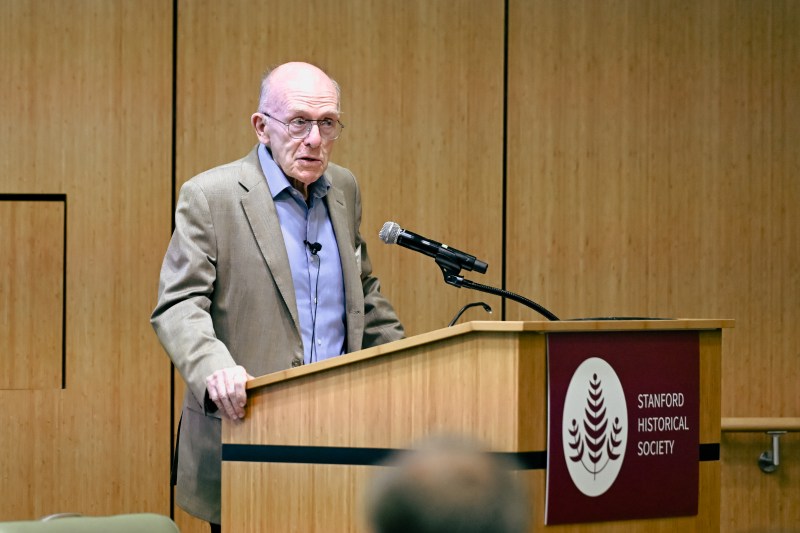As upheaval from student protests continues to shake universities and put pressure on its administrations, the Stanford Historical Society (SHS) gathered on Wednesday to reflect on the role of the University’s president and its evolution over time.
Following the recent announcement of Jonathan Levin ’94 as the 13th president of Stanford, three experts on Stanford’s history surveyed how the role and selection process have changed over the 12 presidencies since 1891.
James Sheehan ’58, the Dickason Professor in the Humanities Emeritus, called 2024 “the year of the search” for the unusual number of prominent universities that have sought new presidents — including Stanford, Harvard, Yale, the University of Pennsylvania and the University of California, Berkeley. Only Stanford and Berkeley have announced replacements.
“It’s late in the day if you want someone to begin in the fall,” Sheehan said. He speculated that presidential search committees at Stanford’s peer institutions could be “deadlocked,” or, more probably, lacking candidates.
“They may be having trouble finding someone willing to take this job,” he said. “It is an incredibly difficult and trying job under the best of circumstances. There’s reason to think we’re not in the best of circumstances.”
At Stanford, Levin will succeed President Richard Saller, who stepped into the role following former President Marc Tessier-Lavigne’s resignation last August. Tessier-Lavigne resigned after a University investigation into his research, following concerns about manipulated images raised in a Daily investigation last fall.
The presidents of Harvard and the University of Pennsylvania both resigned amid criticism over their responses to antisemitism on their respective campuses, particularly following a December congressional hearing where they appeared to evade the question of whether students who called for the genocide of Jews would face disciplinary action.
Panelists at the SHS discussion also reflected on Levin’s “insider” status as the current dean of the Graduate School of Business, as well as an alum and former chair of the economics department. Levin has “deep roots in the institution,” Sheehan said. Levin will also be the first University president since 1968 to hold a degree from Stanford.
Honorary professor emeritus of English William Chace traced the complexity of the modern University presidency to Wallace Sterling, who led Stanford from 1949 to 1968. Sterling’s time in office transformed “the constellation of American higher education,” Chace said.
According to Chace, Stanford was “provincial, suburban, young, lacking in faculty strength and lacking a strong endowment” at the beginning of Sterling’s term. During the postwar era, however, Sterling presided over the University’s rapid ascent in funding and prestige.
“Thus [began] the growth of what was once orchards and vegetable gardens into what we know today as Silicon Valley, a global epicenter of innovation, money and influence,” Chace said.
Geoffrey Cox, a senior associate dean at the Graduate School of Education, concurred that since Sterling, Stanford presidents have been akin to “CEOs of major enterprises with complex relationships, with multiple constituencies.”
Sterling was perhaps the first Stanford president to go through a formal search process. Yet Sheehan said Sterling was “not the kind of man who would make a shortlist today. He had virtually no scholarly credentials.”
Modern presidential search processes have emphasized administrative and academic experience as vital qualifications. Dozens of professional search firms assist colleges and universities with academic searches, which Sheehan described as a “sign of the times.”
Although the program mostly focused on Sterling’s legacy, the panelists examined the impact of several other presidents. For example, David Starr Jordan, Stanford’s first president who guided the University through its early days, held strongly eugenicist views.
Ray Lyman Wilbur ’96, who served as University president from 1916 to 1943, secured the role because of his lifelong friendship with U.S. President Herbert Hoover ’95, Sheehan said. The pair met as Stanford undergraduates and remained lifelong friends. Hoover even appointed Wilbur as his Secretary of the Interior, a role that Wilbur held while remaining University president.
During a Q&A session, one audience member asked, “We’re looking for a president who’s going to run the university that Stanford has become, but is anybody questioning the university that Stanford has become?”
Sheehan agreed that Stanford and similar institutions have changed significantly, becoming increasingly complicated. “A president must articulate the reason why we’re here in the first place. And that is one of the great failures of academic leadership,” he said. “That opens up a vacuum into which all kinds of unwholesome things can rush.”
